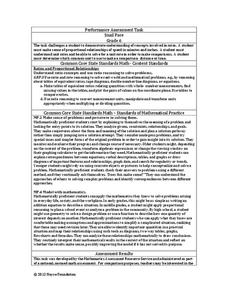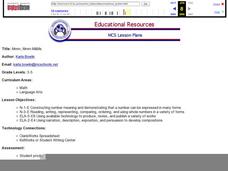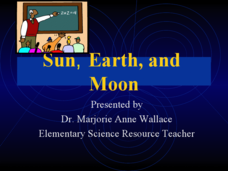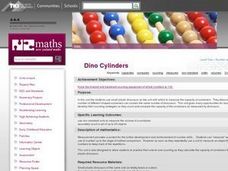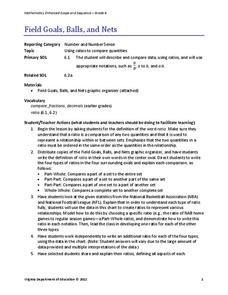Curated OER
How Big Is Your Head?
Students explore measurement by measuring classmates' heads. They record their measurements and they put the measurements in order from smallest to largest. Students figure the mean, median, mode, maximum, minimum, and range of their...
Curated OER
The Tortoise And The Hare
Students use the children's story of The Tortoise And The Hare in order to investigate the graphing of equations. The story is converted to an algebraic word problem for them to solve. Students investigate the relationships of data and...
Curated OER
Investigation - Dividing a Candy Bar
Fourth graders explore dividing equally. They divide three-digit divisors by one and two digit divisors. Students work real life division problems. They examine possible solutions to each problem.
Noyce Foundation
Snail Pace
Slow and steady wins the race? In the assessment task, scholars calculate the rates at which different snails travel in order to find the fastest snail. Hopefully, your class will move much more quickly in finishing the task!
Curated OER
Cause and Effect
Third graders listen to a story read aloud in order to discover the concept of cause and effect. With a partner, they make a cause/effect puzzle from a sentence strip. They then choose and read a story on the internet and make a...
Curated OER
Mmm, Mmm, M&M's
Here is another version of the classic M&M math lesson. In this one, upper graders utilize the ClarisWorks Spreadsheet program in order to document the data they come up with from their bags of M&M's. After making their initial...
Curated OER
Social Problems
An adult ESL class brainstorm what they believe to be the major problems in Namibia. In groups, they use the list of problems and put them into the order of the most critical and the reasons why. They research possible solutions and...
Curated OER
Discovering Elements
A periodic table of elements displays the elements in groups ordered by when they were discovered. Click-by-click, new elements are added, resulting in an almost up-to-date chart. In order to reinforce the idea that symbols are used in...
Curated OER
Prioritizing National Economic Goals
Eighth graders define the generally accepted list of national economic goals. They discuss the compatability/incompatibility of goals. They participate in a consensus-building exercise to rank economic goals in order of importance.
Curated OER
Algebraic Relationships
Here are 17 various forms of problems that range from matching equivalent expressions to word problems. Included are problems for substutiing values into expressions and using the order of operations, simplifying algebraic expressions,...
Curated OER
Conversation Heart Bingo
Primary learners play conversation heart bingo in order to write common phrases. They will create a bingo card with common phrases from conversation heart candy. The teacher calls out phrases and the learners cover them with conversation...
Curated OER
Line With Printmaking
Third graders investigate the use of lines in different pieces of art by creating their own ink print. In this art analysis instructional activity, 3rd graders identify the contours and lines of natural objects such as twigs and...
Curated OER
Sun, Earth, and Moon
Cute graphics make this an attractive presentation for upper elementary classrooms, and multiple choice questions make it interactive as well. There is, however, a lack of coherence. For example, slide #4 addresses the air we breathe,...
Curated OER
Introduce: Summarizing Narrative Text
When scholars re-tell a story, do they boil it down to important details in a logical order? Practice summarizing narratives using this think-aloud strategy, which is scripted here for your convenience. After explaining why this is an...
Curated OER
Center for Northwestern Art: Featured Objects
Each of the slides in this presentation provide learners with an image found at a northwestern art museum and a critical analysis of what can be seen in each piece. Learners can view this prior to a museum trip in order to build...
Curated OER
Relative Pronouns in Spanish
After reading up on relative pronouns and antecedents, Spanish learners can use the menu to navigate the material on the webpage. Each pronoun is paired with an explanation and examples. Within the provided presentation, you will find...
Curated OER
Paws in Jobland: An Interview With...
Elementary schoolers listen and watch television or radio interviews in order to learn interviewing skills. They work in pairs, and "interview" their partner to find out about his/her life, job, and any interesting personal facts. Peers...
Curated OER
Complexity Madness
After introducing the concept and formula for finding the area of a square, try this lesson. Fifth graders will use their prior knowledge to break apart various shapes in order to determine area. This lesson includes several examples,...
Illustrative Mathematics
Voting for Two, Variation 2
John won the election, but by how much more? Your learners will calculate how many votes each candidate received in order to determine the difference. Use with other lessons provided in the series to practice different variations of this...
Curated OER
Decimal Fractions
Young scholars use rounding and compensating with whole numbers and explain how to use the empty number line to show additions and subtractions. They round and compensate in relation to decimal subtraction
Background
Curated OER
Math: Football League Statistics
Young scholars examine a soccer league final standings chart and then answer 12 questions based on the information provided. They calculate some answers in both fractions and percentages.
Curated OER
Dino Cylinders
Pupils investigate the capacity of containers using small dinosaur figures as the unit of measure. They work with a number of different shaped containers to compare the capacity as they practice counting the dinosaurs. They complete an...
Curated OER
Mixed Fraction Sequences
In this math worksheet, students complete the mixed fractions that are sorted into a sequence. The sheet is intended as a teacher's guide.
Virginia Department of Education
Field Goals, Balls, and Nets
Score a resource on ratios. Young mathematicians learn about different ways to express ratios. Using sports data, they write statements about the statistics in ratio form.



